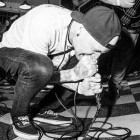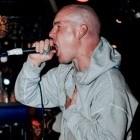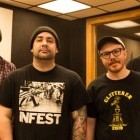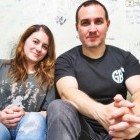
There was something about the way Bad Trip did things that always felt different from their NYHC peers. Formed back in the late '80s, the Queens-based outfit's early material carried the strong sense of melody favored by bands like 7 Seconds and Dag Nasty, while tempering it with metallic overtones. Fronted by charismatic vocalist Fred Muench, Bad Trip's live shows were always packed with wild energy, on and off stage.
Bad Trip broke up in the '90s after a 10-year run, leaving behind two studio albums and three EPs. Since the split, guitarist Arty Shepherd has kept up the busiest musical schedule—appearing in the bands Errortype: 11, Instruction, and Primitive Weapons, among other acts. The other guitarist, Marcos Siega, is a successful film and television director and producer, working on such shows as Dexter, True Blood, and The Following.
Since there isn't much about the band's history online, I reached out to Bad Trip bassist Brendan White to get an overview on their time together, and to see what the other members have been up to since breaking up 20 years ago.
What neighborhood did you grow up in in Queens?
I grew up in Douglaston, along with [singer] Fred Muench, and [drummer] Erik Matheu, and our original guitarist, my brother Brian. [Guitarist] Marcos Siega was from Jackson Heights and [guitarist] Luke Montgomery was from Flushing. We were all-Queens.
Have you always been hugely into music?
I was a big music fan from the time I was about 12, mostly prog stuff, mainstream rock, and '60s stuff at first, then I started getting really into new wave and post-punk. Fred and my brother were basically the same way. We kind of moved into punk and hardcore from there. We never came from a metal background like a lot of other NYHC kids. I got really into Hüsker Dü in about 1984, and that kind of pushed me in that direction, along with seeing Repo Man that year. Once I got into hardcore, though, it became the most important thing in the world to me.
Queens and Long Island had a pretty decent local band scene back in the '80s. Did you go out to a lot of local shows in junior high and high school?
I was a few years older than the rest of the guys in the band, so I really wasn't a part of that scene when I was that age, and we lived a little further out in the borough, so we didn't really have as much exposure to the local scene at that time. I didn't start really getting into hardcore until I was about 18, and even then it wasn't really the NYHC scene, it was more the better-known stuff like Black Flag, Dead Kennedys, and Circle Jerks from the west coast. I really wish I had been a little more with-it back then, there were so many great bands and shows that I could have seen. But by 1985/1986, we got really into the NYHC scene, which was amazing, and we were going to shows all the time.
What was the first band you played in and what kind of style did you guys play?
Bad Trip was the first and only band I was ever in, and that was true of Fred and Marcos as well. I had this cool analog synthesizer in the early '80s, and me and Erik used to mess around in his basement a little bit, playing mostly classic rock covers. But we weren't all accomplished musicians prior to starting the band. In my case, I never was one. I read your interview with Arthur Smilios, and I'm definitely the stereotype of the hardcore bass player that he was talking about. But that's one of the great things about hardcore—there's room for great musicians like him, and amateurs like me.
SEE ALSO: 2016 interview with Arthur Smilios (World Be Free, Gorilla Biscuits, CIV, Token Entry).
When and how did Bad Trip form, and did you have a definite sound you were aiming for from the beginning?
Me, Fred, and my brother were really into the NYHC scene, going to shows all the time, and we sort of conceptually decided to start a band. My brother had taken a few guitar lessons, and we needed to figure out who would play what. We needed a bass player, so I went out and bought a bass and started teaching myself to play. Erik was our friend, and a very good drummer, so even though he wasn't into the music at the time, he joined up. Having someone who could actually play was the only thing that got us past our first practice.
We definitely wanted to sound like a cross between Agnostic Front's Victim in Pain and Straight Ahead/Mayhem, with some 7 Seconds influence thrown in there as well. But we liked all sorts of stuff, so it all found its way in there over time. I always loved the west coast stuff like Adolescents and Bad Religion.
What inspired the band name? It was very different for a hardcore band.
We originally had the ridiculous name Douglaston Mosh Association, which we could never look anyone in the eye while saying. We had a lot of friends from our neighborhood who were into '60s music, including ourselves, so that just popped up one night when we were at a party, and we all quickly agreed. Also, we wanted to make it clear that we were definitely not a straight edge band—although we loved a lot of those bands—and, in fact, I was always straight edge.

Did you play out a lot in those early days of the band?
Not during the earliest days of the band. We weren't the best musicians, although we got better once Marcos joined a few months later on second guitar. He was a soccer star and our friend Vinnie was his teammate and introduced us. We played a few house parties in Queens, some with mostly hardcore-type kids, and some where it really was just typical '80s high school kids. We would do a few originals and a few covers from a variety of musical styles.
In 1987, my brother went away to college, and we were very lucky to get Fred's friend from school, Luke, to play guitar. He wasn't a hardcore kid at all, but he was really talented, and it was funny—but kind of embarrassing—to see him instantly pick up songs we had been practicing for a couple of months and do them perfectly. We started to get serious at that point.
The 1988 demo you recorded was done before you had Marcos in the band, right?
Marcos was in the band almost from the beginning, and wrote a number of the songs from the original 1988 demo, but he had to take a break when he got a full-time job. We did the demo as a four-piece, and started doing our first few real shows at that point. We all really wanted Marcos back in the band, and he wanted back in, so after a hiatus of a few months, he re-joined, and we started putting together a bunch of new songs and playing more shows. He put us in touch with Freddy Alva, who was doing the New Breed tape. It was great to be included on that tape with some of our favorite bands. And "Something More" was definitely one of the best songs we ever did.
The Positively Bad 7" came out in 1989 on a label called Bell Bottom Records. Was that a label the band made up, or was it someone else?
Bell Bottom was run by Jose Ruiz, who later went on to sing for Merel. As far as I know, the Positively Bad 7" is the only record that Bell Bottom ever released. We had been playing a few shows around town, and between the demo and the New Breed comp, I guess people liked what they were hearing. When we started, we thought it would be amazing if we ever put out a demo and got to play CBGB's, but we actually started to have enough decent songs that we were ready to put out a 7".
Marcos wrote about half the music, and I wrote about half, with Luke and Erik also coming up with ideas. Fred wrote most of the lyrics, although I wrote a few songs. I always thought we wrote pretty good lyrics, although they were basically pretty straightforward hardcore themes at that time. I'd say 7 Seconds was a big inspiration lyrically early on.

That session was the first time you worked with Don Fury. What was that experience like?
We loved Don. We ended up doing almost every recording we ever did over the years at his studio. We actually did the first demo there as well, although that was 2-track live. It was challenging doing the 4-track, and then later the 16-track recordings, because we always had a lot of live energy, and it took a lot of focus to stay tight in the studio. And Don had to have a lot of patience to deal with my pretty limited ability as a musician. But we always had a great time hanging out there with him.
SEE ALSO: ABC No Rio Hardcore Matinees 1990 - 1991: A Visual Retrospective
Tell me about the Bad Trip/Go! split tour EP that Skene! Records released in 1990.
We had contributed a song to the Chop Chop comp on Skene! Records in 1989, so we had worked with Jeff Spiegel on that and had a good relationship with him. When Mike Bullshit from Go! asked us if we wanted to go on an American tour with them, we immediately said yes. By that time, the CBGB's scene we had been a part of for the past four or five years had pretty much faded, and we were playing a lot at ABC No Rio with some great bands. We felt that our lyrics fit in a little better with that scene than with what the CBGB's scene had become by that point.
Go! had gotten the word out around the country, so we were able to get a bunch of shows coast to coast. We had a show booked for Minneapolis, where Skene! was located, so Jeff asked the bands if we could squeeze in some studio time. We had been playing "Quick Fix" out for a pretty long time at that point, but it never made it onto the 7", so it seemed like the perfect opportunity to get it on vinyl. We had our friend Tom playing guitar on that tour, so it was good to get a recording with him on it. I think Go! actually wrote all their songs for that split while we were on tour.
In addition to the split, Skene! also released a 12" comp called Can You Break Through, which also featured the songs from the split. Somehow, Green Day also appeared on that record. All in all, it was an extremely memorable tour, for all sorts of reasons, including getting to play with MDC, one of my favorite bands.
An artist Bad Trip worked with throughout the years was Jordin Isip.
Jordin grew up in Douglaston with us. A lot of our friends were artists, so we were always lucky to have connections when it came to cover and t-shirt art. Another good friend was Carl Dunn, who did our first demo cover, the Buzzy cover, and a shirt design. But Jordin definitely was closely linked to the band. He had been into hardcore earlier than any of us, so we often went to shows with him. He designed the Bad Trip logo for our first t-shirt design, which we used right up to the end, and certainly was strongly identified with us. I don't think Jordin ever liked that logo, but we loved it.
We were interested in having a look that was different from a lot of the other NYHC of the time, so I think Jordin's expressionistic drawings and other works gave us our own visual image. Obviously, we were lucky to be able to work with such a talented artist, who went on to become a professional illustrator.
We're all still friends, and see each other all the time at card games, concerts, parties, etc.

Speaking of Isip, he created the cover for Bad Trip's debut album, 1992's Fear and Loathing. That was the band's first release through the Wreck-Age label.
We loved that album. We were a pretty slow-moving band. I think just about all the songs were written by 1990, and the album came out two years later. We would just occasionally go a few months without doing anything with the band, and then realize that we needed to get our act together. We did a southern US tour in early 1991, and then took a break for a while. Me, Fred, and Erik still hung out all the time, and gradually we started saying we needed to do another record and start playing shows again. We had talked with Skene! about putting out a record, but it never worked out for some reason. We decided to just hit the studio and record an album on our own, and pretty soon Don Fury told us that Wreck-Age, which was pretty new at the time, was interested in releasing a record for us.
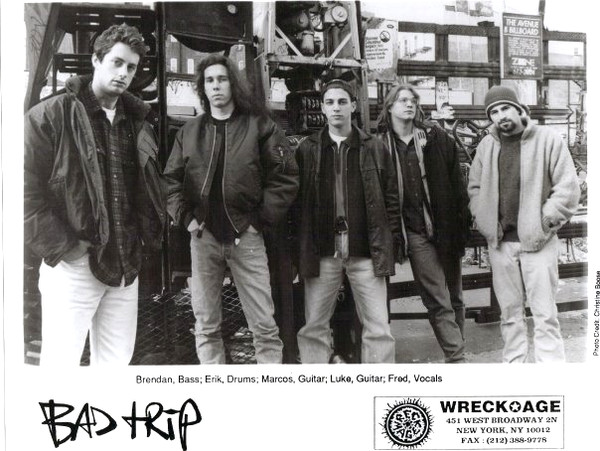
Was working with Wreck-Age easy?
We liked [Wreck-Age founders] Amber [Green] and Pavlos [Ioanidis] a lot. They were pretty easy to deal with, although our records always seemed to come out a week after we finished touring. But they were very open to whatever we wanted to do, and they definitely helped us to get shows and to arrange tours in Europe.
In retrospect, Fear and Loathing was a pretty accurate representation of Bad Trip circa 1990 - 1991. Some of our best songs are on that record, and I think the music and artwork were different from a lot of other stuff that was going on in NYC at the time. We had definitely progressed a lot since 1986. All that being said, I think it sounds a little too metal, listening to it 25 years later. I would have preferred a sound a little more like Dag Nasty.
Did you tour the album a lot? I know you guys had a pretty decent following in parts of Europe.
We did a tour of Europe in the fall of 1992. Unfortunately, the record wasn't out yet, so very few people at the shows knew any of our songs. Doesn't matter. I wouldn't trade that experience for anything. We had some of the worst experiences you could imagine, straight out of Spinal Tap and worse—including van crashes, Nazi skinhead attacks, fights, cancelled shows, getting deported, some of the most lowdown squats in Europe, lost a lot of money. But we had some amazing positive experiences, including so many memorable shows. The crowds were so much fun. We were one of the earlier American bands to play Poland, and they were so excited to see any American punk band, they just put it all out there. It's funny, because we were playing a few shows with Downcast at the time, and they were more into the Fugazi type of live atmosphere. They even stopped playing when the crowd kept slam-dancing. We were totally cool with that kind of thing, on the other hand.
In the end, they all seem like positive experiences. We toured with Hammerhead, a great German hardcore/punk band. They were the best. We're still friends with them, thanks to the magic of Facebook.

Sometime after Fear and Loathing, one of your guitarists, Luke Montgomery, left the band.
A lot of the negative experiences on that tour were still pretty fresh in our minds at the end of the tour, and Luke needed a break. He just started walking a little faster than us when we got to JFK airport, and never looked back. A few months later, we called him when we were ready to start playing again, and he told us he couldn't do it anymore. It was a serious blow, because he was a great guy and an amazing guitarist. But in reality, this wasn't the kind of music he really wanted to do. Everything ended on good terms.
SEE ALSO: 12 Newer Hardcore Bands to Check Out in 2016
You then brought in Arty Shepherd, a guitarist who was also a member of Long Island's Mind Over Matter.
We had played with Mind Over Matter a couple of times at that point, and Arty was a fan. We really didn't know him personally, though. Amber and Pavlos told us that he heard we were looking for someone to replace Luke, and he was interested. It turned out to be a great thing for the band. By that point, we were incorporating a lot of different influences into our sound, and we had already written the songs for the Elevator EP before we went to Europe with Luke. Arty's style and musical interests fit in very well.
He was also a little younger than everyone else in the band, so he was a link with the younger, more '90s hardcore kids. We were never really scenesters, so that was good for us. We actually started playing out a lot more at that point, and Arty was a lot of fun to play with live.

The next release after the album was the Elevator EP from 1993. The first song on that record, "I Know," is my all-time favorite Bad Trip song. I love your intro bassline!
Marcos wrote "I Know," including the bassline. I remember he came over to my parents' house one night and he just showed me the whole song, including exactly how he wanted the bass part to go. It really is a great tune, and was always popular live. Fred's lyrics and vocals were really good as well. The whole EP showed us moving in a somewhat different direction. I don't think there's anything on there that could be seen as straightforward hardcore, but in the context of the time, it still felt like hardcore to us. It was just that the definition kept getting broader.
I wrote the lyrics to "Stockholm Syndrome," which was inspired by Obedience to Authority, by Stanley Milgram, discussing how experiment subjects were willing to torture others when they were told to by someone in a lab coat. I was a Sociology major in school, so I was really into that kind of thing.
Two years after Elevator, the band issued its sophomore album, Buzzy. That record was far removed from the hardcore elements of your earlier material, showing off a much moodier kind of vibe.
Buzzy was really just a continuation of the type of stuff we had on Elevator, and to an extent on Fear and Loathing. One thing that was different was that a bunch of the songs came about from me, Erik, and Arty just jamming in Erik's basement, rather than the usual way of one of us showing up and saying, "I have a new song." But there were a few of those as well.
All of us were always into all sorts of music, so it was natural that we wanted to try a lot of different things, everything from Fugazi and other Dischord bands, Rorschach, Bad Religion, definitely some Sub Pop and Amphetamine Reptile stuff. We all liked Pavement. And, of course, some of the stuff the other New York bands were doing at the time, which was being called "post-hardcore." Like I said, though, I still considered it all to be hardcore. The only real musical philosophy we ever had was that we wanted all of our songs to sound different from one another, rather than just have an identifiable Bad Trip sound. We were that way from very early on.
My only gripe with the album is the recording. How do you feel about Don Fury's mix?
It wasn't the mix. Don worked very hard with us to get a good sound, and it sounded amazing in the studio. Something weird happened in the mastering process, because the cassette version sounded different from the vinyl and CD versions. Marcos' guitar got lost somewhere on those. We really loved that record when we were doing it, but it left a bitter taste in our mouths because we didn't think the finished record sounded the way it did when we recorded it. Also, we had this one song, "Taking Time," that we really liked, but for whatever reason, we made this bizarre choice not to include it on the record, and it only appeared on the CD. We weren't really all seeing eye to eye on a few things.
I remember seeing the band play a show at Coney Island High after the album came out, but I don't recall you touring a lot for the album.
We did a large European tour in May/June of 1995, but again we got stuck on the road before the album came out, so no one knew any of the new songs. We weren't really in a very good place at the time, and I think we could see that we were nearing the end of the line. Some of the shows went very well, since we had toured there a couple of times already and people knew the older songs, but it just wasn't a very fun tour. I had just graduated law school, and wanted to dive head first into the tour, but it just wasn't happening. Real life was getting too much in the way. We did a few more shows when we got back, but that was pretty much it.
The band ended right then?
Marcos was really starting to get serious about wanting to do music videos, and he had to turn down work to go on tour. And being in the band was certainly no way to make a living. It cost us money. That was okay, because we loved doing it, but it was just at the point where he couldn't do both anymore. Which is completely understandable, since we were all in our mid- to late-20s, had been doing the band for nearly 10 years. The rest of us briefly considered keeping going, but we decided to bow out gracefully. We did one final show at CBGB's, which was fun. All of our friends came down.
As it turned out, I had to take the bar exam and look for a job as an attorney, so I didn't exactly have a ton of time anyway. It was a minor miracle that we toured Europe twice and put out two records while I was in law school. I have a lot of respect for the hardcore bands that have kept it going for such a long time, but to be honest, I never planned on being a professional musician, even if that were a realistic possibility. We accomplished far more than we ever set out to do, and that was good enough.
Did you even attempt to play in any bands after Bad Trip?
Nope. That was the end of my career as a musician. I still would mess around with the guitar or bass a little bit, but I was satisfied with what I had done in Bad Trip. Erik and Arty went on to do Errortype: 11 for a few years, and Arty is still playing in a number of bands. Luke moved on to the folk and jam band scene, and he's still playing out all the time. It's good that the real musicians are still out there doing it.
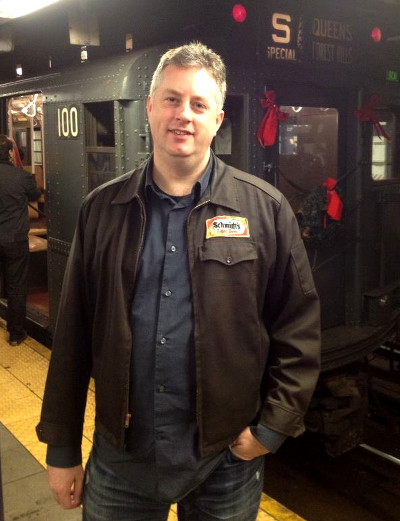
Marcos has gone on to become a director, working in both television and film, and Arty has played in bands like Instruction and Primitive Weapons. What have you and the rest of the guys in Bad Trip been up to in the year since the band?
I'm a criminal defense lawyer in Manhattan, which I've always looked at as sort of the punk rock of law. I definitely continue to follow the D.I.Y. principles and overall beliefs I had from the hardcore scene in my business and life overall. Fred works as a psychologist, which makes some sense based on the social justice and intrapersonal themes of many of our lyrics; and Erik runs an energy management company in Queens. I couldn't have asked to be in a band with a better group of guys.

Bad Trip played a reunion show back in 2010 at ABC No Rio. Would you be open to playing with the guys again?
I don't know. Maybe. We hadn't played together in 15 years at that point, and it was so much fun to get together. I had to do a fair amount of practicing to be ready for it. Mike from Go! put it together in honor of the 20th anniversary of our US tour together, and it was great to play with them again—and with our longtime friends from Inflatable Children—at ABC No Rio, where things are still going strong. But we really kind of viewed it as a one time thing. If we were to do it again, I doubt it could capture the energy of that one show. On the other hand, we still love the music, so you never know.




